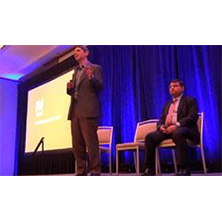The biggest challenge for enterprises is weighing up present day investment, cost, complexity and ROI versus the maintenance of old systems. The dilemma is choosing between short term problems and risks and long term benefits.
So how do you decide if your company is ready for Legacy modernization?
Consider this – Your enterprise has been using large, impenetrable, character-based legacy IT applications built on Mainframe or AS400. Your resources are busy maintaining highly convoluted, millions of lines of codes that are becoming difficult to handle and are gradually losing pace with the more dynamic and networked world. Your competitors and vendors are migrating to cloud-based and Service Oriented Structure (SOA), using agile, web-based, usability driven applications that are scalable and well integrated with other applications for a more organized, innovative, efficient and fast paced business. There have been many acquisitions, mergers, and partnerships based on re-defined business processes that asked for modernized, user-driven applications.

Presently, your legacy applications seem to be performing well. But, the localized mainframe applications were built to carry out silo procedures unable to share code even with same functions.
At times, your enterprise may have difficulties finding vendors and business partners as majority have been moving to Windows, UNIX, LINUX, etc. Also, your company might be overloading mainframe systems and using the last MIPS of expensive power but with regularly deteriorating performance.
Still, your company has been resisting change fearing risk and complexities. But how far can you postpone the inevitable? Does any system come without an expiry date? The answer is ‘No’ and the respite is Legacy Modernization.
What are the Advantages of Legacy Modernization?
Legacy IT Modernization can bring competitive advantage to your enterprise by providing tremendous benefits to IT and business, including:
Reduced Complexity and Dependency: Mainframe has been around for more than four decades, resulting in millions of lines of COBOL code that is becoming too cumbersome to manage. The procedural programming is based on instructions and can be used by well-trained resources only. Moreover, the universities worldwide now teach new age languages that leaves few retired or soon to retire resources of languages like ADSO, IDEAL. The scarcity of resources and depending on legacy skills is not only expensive, but also slows down the business. Modernization of legacy applications to open, agile, web-based systems helps to deal with legacy crisis. Also, any developer trained on new languages can easily maintain them.
- Easy Maintenance: Unlike the localized and monolithic legacy applications, new age applications are less complex and highly flexible. Applications, operating in a cloud-based systems offer greater mobility and can be accessed and maintained from anywhere. It is easy to maintain automated processes of well-integrated applications that re-use code. Moreover, there is no crisis of resources for maintaining such applications.
- Increased Efficiency: Compared to Mainframe, language neutral platform like Windows is more efficient. Legacy applications are being replaced by modularized, flexible, event-based, usability driven, Java and .Net applications. Application modernization can help enterprises migrate their assets to more efficient, open, scalable, Cloud and SOA based systems with better integration and functionality as they leverage cloud computing, development and operations (DevOps), and big data processing tools that are needed fora mobile, well-connected,and socially aware world.
- Improved Compliance: An enterprise gets an edge over its competitors if it can assure its customers of delivering the best value and services by adhering to process compliance regulations like Sarbanes-Oxley and HIPAA. Legacy modernization helps in maintaining updated, regular logs and reports from anywhere and at any time, which was a big hurdle with paper-based legacy systems. Real-time accessibility of modern applications, easy data entry through mobile devices, increased security through geo-fencing and encryption, improved accuracy in time entry, project status tracking has all resulted in better customer support, reduced risks, fewer audits, and easy compliance.
- Aligned Business & IT: Enterprises find difficult to align business and IT goals. LOBs intend to use the company budget on getting customers and increasing innovations whereas IT is occupied more with maintenance of legacy applications. Also, with expensive mainframes, just 25 -30%of budget is left for new projects. Application modernization not only saves developers of all the maintenance time, but also boosts their morale, increasing their productivity and driving them towards innovations.
- Decreased Cost: Mainframes has been demanding high upgrade prices and license fee being the quintessential provider of high power, availability, and security. The reliability of mainframes is undoubtedly capable of the ethos that it has commanded, but the cheaper options like Windows do not provide less. Purchasing or upgrading even a minimum of mainframe MIPS makes other new options more attractive. Modernization of legacy IT applications can save labor cost by automating manual writing of codes, reusing code, optimizing business processes, decreasing maintenance costs by switching to more modern, low-cost platforms.
- Improved Business: Companies with application modernization can provide better services to customers and vendors and have better chances of getting business. With web-based, scalable applications, enterprises find it easier to link with customers with upgraded systems. Modernization of applications has resulted in better code, well managed databases and platforms, SOA based flexible and integrated application. Web-enabled applications that integrate easily with mobile devices enable online transactions, social media interactions, and use of public and private data for various analytics. These offerings and latest IT trends are too lucrative for any customer. Business is further facilitated with networking of applications, paperless reports, improved compliance, which are only some of the factors that reduce the time and cost of projects and improve business.
Enterprises using Mainframe have their hands tied – they know they are paying too much for the security and reliability that they have been enjoying since ages. They realize the advantage of more efficient yet cheaper platforms, but are apprehensive of legacy IT modernization.
The Real Challenge
The biggest challenge is weighing between present day investment, cost and complexity, and ROI versus maintenance of old systems. The dilemma is choosing between short term problems and risks and long term benefits.
So how do you decide if your company is ready for Legacy modernization? Check if your legacy applications to meet your business needs? Consider how old your mainframe systems are, analyze present operating cost, and check out modernization strategies like screen-scraping, application integration, replacement with COTS offerings, re-hosting business logic and data to agile platform Or re-structuring to C++, Java or .Net like architectures.
Wrapping Up
Choose the options that work best for your enterprise. The result should be overhauled, efficient applications that are built on the strengths of the past, provide competitive advantage to your enterprise, and help you in facing future business challenges.

Shashin Shah has been an expert in the Information technology field for more than twenty years. His experience globally and in the US, spanning across several industries has greatly contributed to his unparalleled skill set. Currently, Shashin is working as Chief Business Officer at DTES division of Happiest Minds, where he is primarily handling Pimcore Global Services. Pimcore is 100% open source consolidated platform for PIM, MDM, DAM, WCM & Ecommerce.








